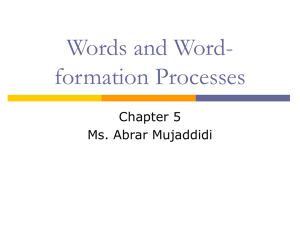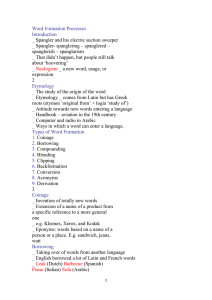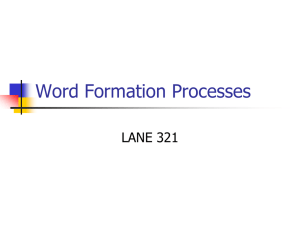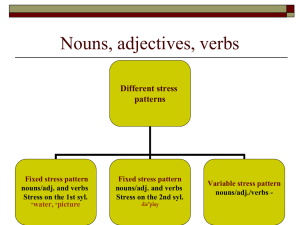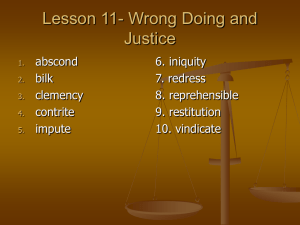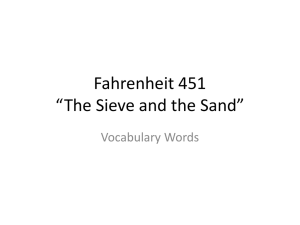Words and word-formation processes
advertisement
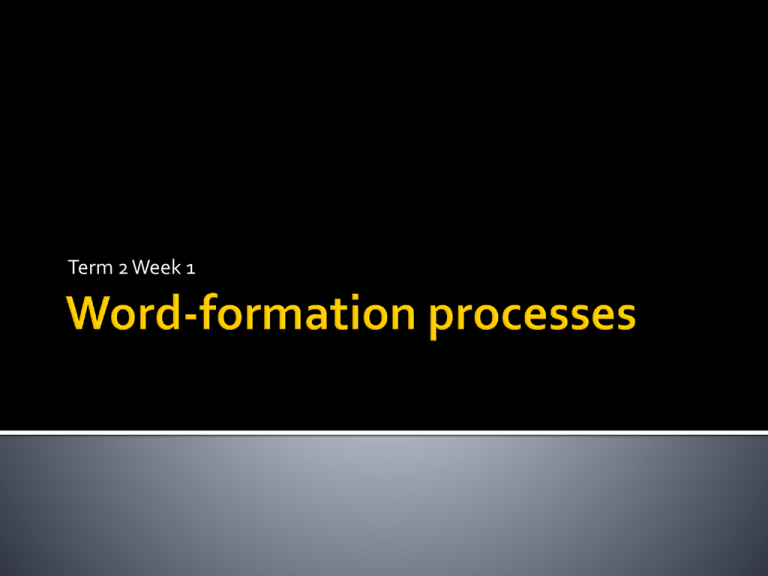
Term 2 Week 1 How receptive are people towards new words? Do people accept the use of different forms of that new word easily? There is a lot of regularity in the word-formation processes in the English Language. The study of the origin and history of a word is known as its etymology. There are many different ways in which new words can enter the language. A lot of words in daily use today were, at one time, considered barbaric misuses of the language. In the early 19th century, words like handbook and aviation horrified readers of a London newspaper. Yet many new words can cause similar outcries as they come into use today. Rather than act as if the language is being debased, most linguists prefer to view the constant evolution of new words and new uses of old words as a reassuring sign of vitality and creativeness in the way a language is shaped by the needs of its users. The invention of totally new terms. The most typical sources are invented trade names for commercial products that become general terms (usually without capital letters) for any version of that product. Examples include Kleenex, Teflon, Tylenol, aspirin, Vaseline and zipper. New words based on the name of a person or a place are called eponyms. Examples: Sandwich – from the 18th century Earl of Sandwich who first insisted on having his bread and meat together while gambling. Jeans – from the city of Genoa where the type of cloth was first made. One of the most common source of new words in English is the process of taking over words from other languages. Throughout history, English has adopted a vast number of new words from other languages, including croissant (French), dope (Dutch), lilac (Persian), piano (Italian), pretzel (German), sofa (Arabic), tycoon (Japanese) and yogurt (Turkish). A special type of borrowing is described as loan translation or calque. In this process, there is a direct translation of the elements of a word into the borrowing language. The American concept of ‘boyfriend’ was a borrowing, with sound modification into Japanese as boifurendo ボイフレンド, but as a calque into Chinese as nan pengyou 男朋友. The joining of two separate words to produce a single form is known as compounding. Common English compounds are bookcase, doorknob, fingerprint, sunburn, textbook, wallpaper, wastebasket and waterbed. The combination of two separate forms to produce a single new term is called blending. Blending is typically accomplished by taking only the beginning of one word and joining it to the end of the other word. Examples: Brunch = Breakfast + Lunch Smog = Smoke + fog Motel = Motor + Hotel Telecast = Television + Broadcast Infotainment = Information + Entertainment Clipping occurs when a word of more than one syllable (facsimile) is reduced to a shorter form (fax), usually beginning in casual speech. Common examples include ad (advertisement), cab (cabriolet), condo (condominium), fan (fanatic), flu (influenza), perm (permanent wave), pub (public house) etc. A particular type of reduction, favoured in Australian and British English, produces forms technically known as hypocorisms. In this process, a longer word is reduced to a single syllable, then –y or –ie is added to the end. Examples include movies (‘moving pictures’) and telly (television’). Typically, a word of one type (usually a noun) is reduced to form a word of another type (usually a verb). A good example of backformation is the process whereby the noun television first came into use and then the verb televise was created from it. A change in the function of a word, as for example when a noun comes to be used as a verb (without any reduction), is generally known as conversion. Examples of nouns converted to use as verbs include bottle (bottled the home brew), butter (buttered the toast), chair (chair the meeting), spy etc. It is worth noting that some words can shift substantially in meaning when they change category through conversion. The verb to doctor often has a negative sense, not normally associated with the source noun a doctor. Acronyms are new words formed from the initial letters of a set of other words. These can be forms such as CD (compact disk) or VCR (video cassette recorder). Many acronyms simply become everyday terms such as laser (light amplification by stimulated emission of radiation) and radar (radio detecting and ranging). The most common word formation process to be found in the production of new English words. Derivation is accomplished by means of a large number of small ‘bits’ of the English language which are not usually given separate listings in dictionaries. The small ‘bits’ are generally described as affixes. Some familiar examples are the elements un-, mis-, pre-, -ful, -less, -ish, -ism and –ness which appear in words like unhappy, misrepresent, prejudge, joyful, careless, boyish, terrorism and sadness. Although we have concentrated on each of these word-formation processes in isolation, it is possible to trace the operation of more than one process at work in the creation of a particular word. For example, the term deli seems to have become a common American English expression via a process of first borrowing delicatessen (from German) and then clipping that borrowed form. Forms that begin as acronyms can also go through other processes, as in the use of lase as a verb, the result of backformation from laser. In the expression waspish attitudes, the acronym WASP (‘white Anglo-Saxon protestant’) has lost its capital letters and gained a suffix (-ish) in the derivation process. Many of these new words can have a very brief lifespan. The generally accepted test of the ‘arrival’ of recently formed words in a language is their published appearance in a dictionary. How will an understanding of word-formation processes aid your understanding of a text, in relation to its purpose, target audience, context and culture?

